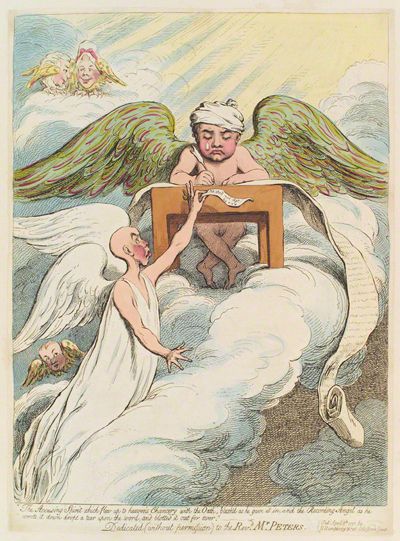The Accusing Spirit which Flew up to Heaven's Chancery. . .
Gillray's title is a quote from Volume VI Chapter 8 of Laurence Sterne's Tristram Shandy when Uncle Toby and Corporal Trim argue about the likely fate of the dreadfully ill Ensign Le Fever. Toby argues that with the loving care that he and Trim are willing to provide, Le Fever will live to march another day. Trim, on the other hand, persists in believing that Le Fever will "never march, but to his grave." Increasingly distressed by that potential outcome, Toby cries out that "He shall not die" and caps it off with an oath. And it is at that point that we get the sentimental lines from Sterne that Gillray uses as his title.
The accusing spirit which flew up to heaven's "Chancery with the oath, blush'd as he gave it in, and the recording angel, as he wrote it down, dropt a tear on the word, and blotted it out for ever.

© National Portrait Gallery, London
Gillray's rather odd-looking print is a graphic illustration of those lines, with a bald accusing spirit flying up to heaven holding a paper with the oath: "He shall not die, by G-d!" and the Recording Angel (who seems to be have been roused from bed wearing nothing but a night cap) dropping a tear which effectively blots from the record Toby's sin of having taken the Lord's name in vain.
The print is "Dedicated (without permission) to the Rev'd Mr. Peters", and this may provide a clue to its intent. Matthew Wiliam Peters was a small time painter of portraits and genre and religious scenes, successful enough to have been a member of the Royal Academy and to have received commissions from Alderman Boydell for his famous Shakespeare Gallery. After making his reputation in the art world for erotic portraits such as Lydia (1777), Hebe (1779), and Belinda (1777), he became an ordained clergyman in 1781, and produced sentimental religious paintings including The Resurrection of a Pious Family, The Angelic Child, and An Angel carrying the Spirit of a Child to Paradise. To someone schooled by the Moravians whose brother had died at one of their schools, Peters work must have seemed like so much literal-minded, pious cant. So Gillray may have intended his print to be a parody of the kind of sentimental religiosity Peters seems to have been so successful at exploiting.
If so, the two love birds of prey in the background may be Peters and his wife, who married in April of 1790.
Sources and Reading
- Commentary from the British Museum on The Accusing Spirit which Flew up to Heavens Chancery. . .
- "Laurence Sterne," Wikipedia
- "William Peters (painter)," Wikipedia
- "Matthew William Peters, R.A.," A Dictionary of Irish Artists
Comments & Corrections
NOTE: Comments and/or corrections are always appreciated. To make that easier, I have included a form below that you can use. I promise never to share any of the info provided without your express permission.